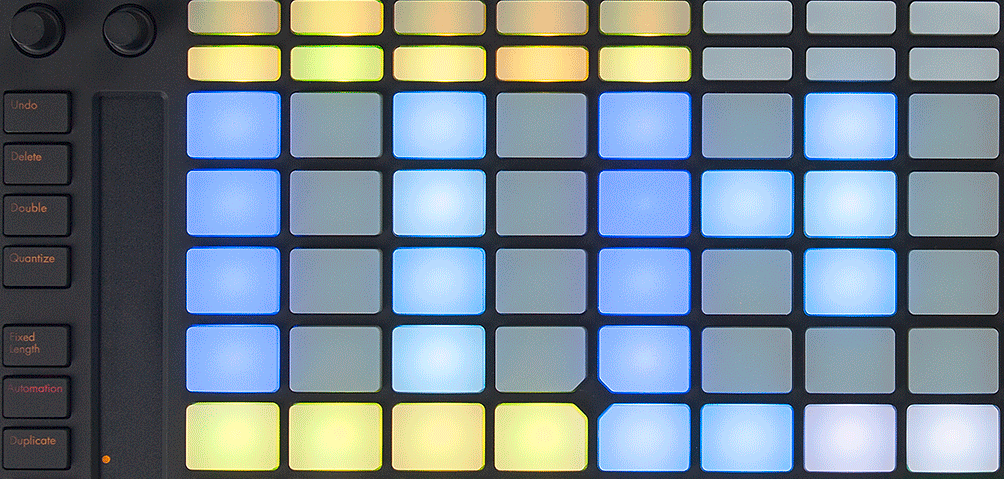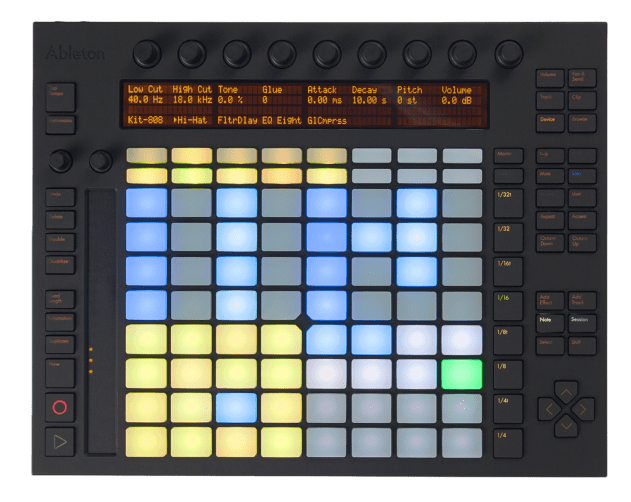Digging deeper
As intuitive as Push is to begin with, you’ll also find a huge range of slightly less obvious options waiting for you once you drag yourself away from playing with it and dig into the manual. My initial experience with Push was impressive enough in its own right, but once I started to explore the deeper features over the course of the next few weeks I was even more impressed.
Note mode takes a little getting used to with the notes spread across the 64 pads, but once you’ve got the hang of the concept it becomes an interesting approach to playing melodies and chords. The Scale button allows the pads to be limited to a chosen scale and key to ensure you play in tune with other parts of your set (you can also switch to chromatic mode if you choose). User mode is one of the less exciting aspects of Push since it’s closest to what any other controller can do, but it allows the unit to act as a standard MIDI controller, with each control sending CC messages which can be mapped to parameters in software.
Parameters in third-party plugins are quickly and easily mapped to the Push’s device controls using the macro controls. The addition of polyphonic melodic step sequencing in the Live 9.1 update is a major bonus, allowing melodic patterns to be programmed in a totally different way, inspiring melodies you wouldn’t necessarily come up with using the 8×8 grid approach (or, for that matter, using a MIDI keyboard). You can also now sequence parameters such as tuning and decay for each individual step.
Over the course of a couple of months with the Push so far, it’s gone from being a controller which works neatly alongside the software to the main focus of my workflow whenever I use Live. It can easily become the primary approach for drum programming, melodic jamming, mixing and arrangement.
The addition of polyphonic melodic step sequencing in the Live 9.1 update is a major bonus.
Best of all is the way the workflow is so seamless as you move from one task to another. You’re never more than a couple of button presses away from diving into a device to adjust a setting, change the parameters of a loop, record automation or add entirely new elements to a set.
Conclusion
At first glance, Push might appear to be ‘just’ another controller. In use it proves much more than that. It’s not strictly a hybrid in the same sense as a product like NI’s Maschine: you don’t need Push to use Live 9, and it doesn’t necessarily allow you to do much which the software couldn’t do without it. Instead, Push simplifies and opens up a huge number of options built into Live. It’s a physical, hands-on rethinking of the Ableton production process which can transform the way you go about making music with Live 9.
Ableton promotes Push as an instrument rather than a controller. It’s easy to see why. There are a lot of options on the market if you’re looking for a controller to use alongside Live, but Push beats them all. It’s significantly more expensive than the likes of the Akai APC40, but it’s so much more than just a simple controller. It’s the best hardware counterpart to Live by quite some distance, and one which is almost guaranteed to change the way you approach making music.
The Verdict
Price: from €578
Purchase: Ableton Push
The Final Word
More than just a controller. The perfect hardware companion to Ableton Live.


04.57 AM
it’s unreal how badly I want one of these
08.52 PM
Thank you for the review. It makes perfect addition to my thoughts. PUSH is an instrument, the ultimate instrument for Live.